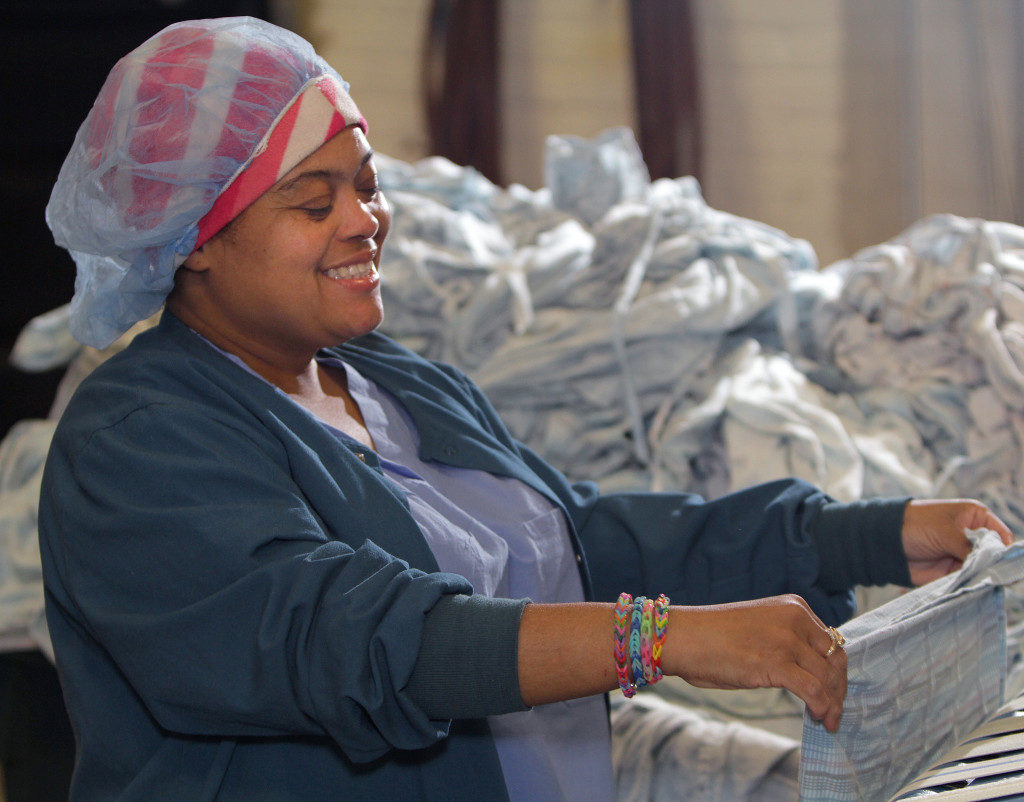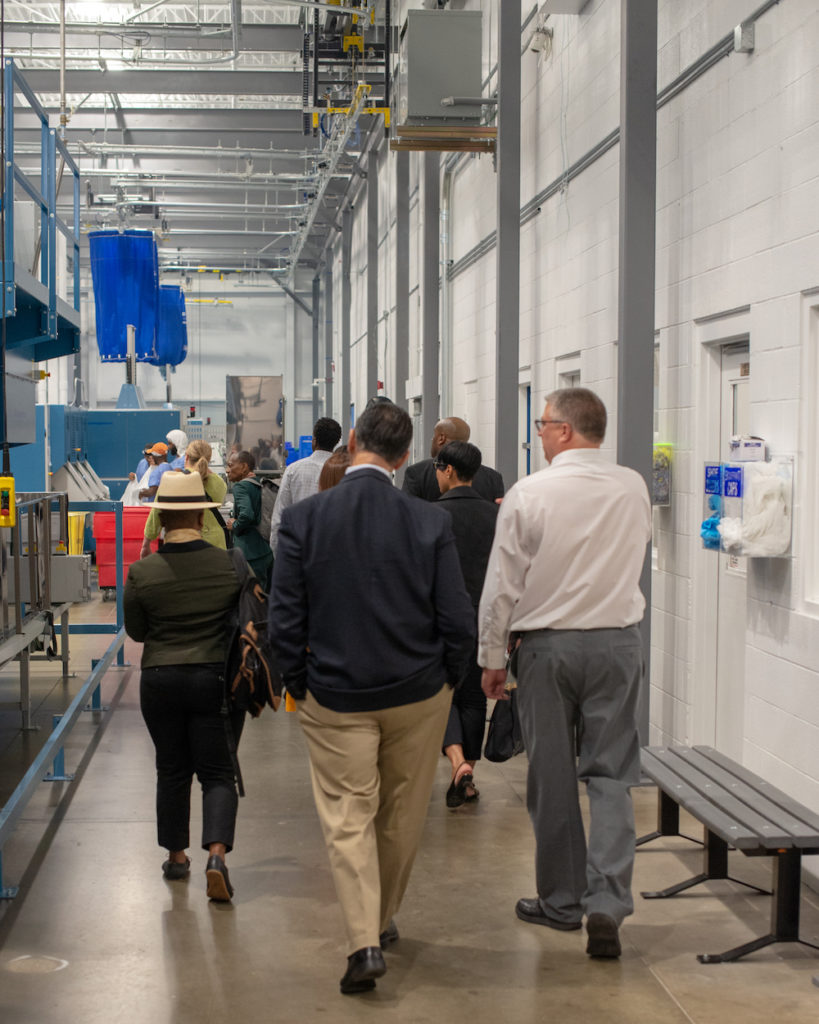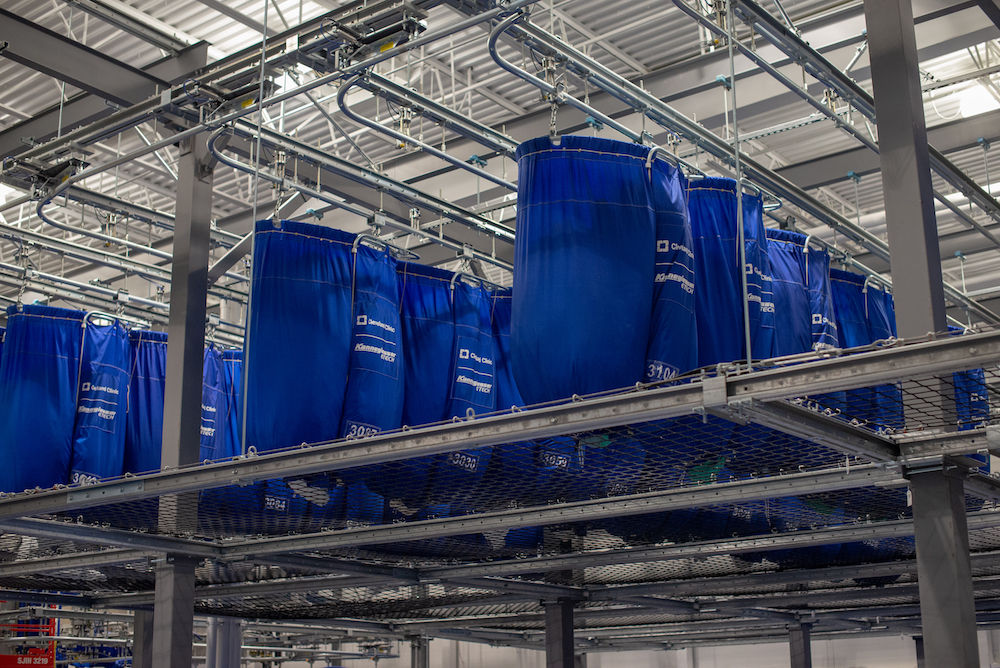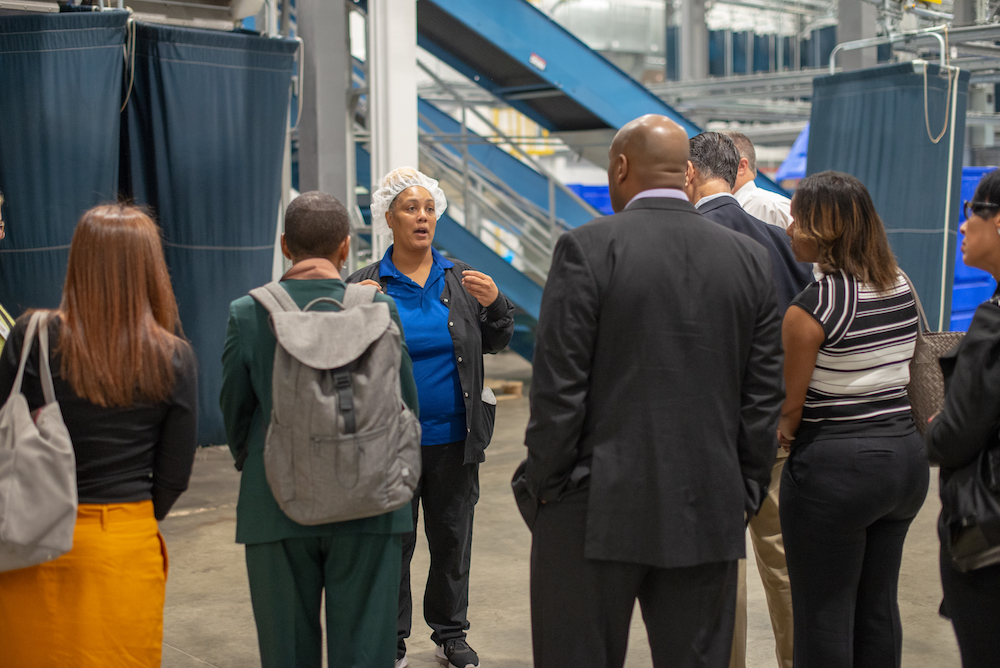Evergreen Cooperatives plans expansion of its laundry co-op model to New Haven and other cities
by Karen Kahn

In February 2018, Cleveland’s Evergreen Cooperative Laundry won a competitive bid to operate the Cleveland Clinic’s industrial laundry. Taking over the operation immediately tripled the size of this worker cooperative, creating nearly 100 new jobs with ownership pathways and demonstrating a new model for scaling cooperative ownership: a tight focus on expanding in one industry that the enterprise knows well. Now Evergreen is poised to expand the model it developed in Cleveland to other major cities, including New Haven, Connecticut.
Commercial laundries, says John McMicken, CEO of Evergreen Cooperatives, provide a real opportunity for growing Evergreen’s community wealth-building strategy. The Evergreen model is based on the idea that anchor institutions — such as large hospitals or universities — can, by buying locally, have a significant beneficial impact on local economic development. To ensure that this economic development is inclusive, the model incorporates principles of democratic ownership: by developing employee-owned businesses to meet the supply chain needs of the anchor institutions, the model creates wealth broadly held at the community level.
In Cleveland, the Cleveland Clinic, University Hospitals, and Case Western University have worked with Evergreen to help grow three cooperatives — the laundry, an energy efficiency business, and an industrial scale urban farm — by buying locally. These cooperatives, in turn, employ people from marginalized communities. Over half of the cooperatives’ employees, for example, are returning to the community after serving time.
Commercial laundries, says John McMicken, CEO of Evergreen Cooperatives, provide a real opportunity for growing Evergreen’s community wealth-building strategy.
Commercial Laundry Provides Good Jobs
With the new laundry contract , the Evergreen Cooperative Laundry has become a sizeable operation, now employing 165 people and processing 28 million pounds of laundry per year. McMicken says the commercial laundry sector has several characteristics that make it attractive to Evergreen:
- Hospitals, a major anchor institution in many communities, produce a lot of laundry — and much of this business has been outsourced to national firms that are now pulling out of the sector;
- Keeping laundry service local saves on transportation costs and decreases processing time, which further reduces costs because the institutions need less inventory;
- The business is highly specialized and capital and labor intensive, reducing competition and creating good jobs with career paths for employees.
Additionally, through its employee-owned model, Evergreen believes it can improve the quality of jobs above what is typical in the market. When Evergreen took over the Cleveland Clinic laundry, workers immediately saw their wages go up, from an average of $9 to $11 per hour. In addition, they were given an accelerated path to equity ownership. Of 100 new hires, 60 were recently voted in as cooperative members, giving them the opportunity to share in yearly profit distributions and in other benefits such as low-interest home loans. “Profit distributions last year increased wages by $3 per hour,” says McMicken, “and may double this year.”
Good wages, employee-engagement practices such as open-book management, and career paths increase workers’ commitment to ensuring quality outcomes.
The laundry business also offers real opportunities for career growth. A commercial laundry is run using computerized technology, McMicken explains. There are frontline operators, IT positions, maintenance and logistics positions, and management positions in the varied departments.
Good wages, employee-engagement practices such as open-book management, and career paths increase workers’ commitment to ensuring quality outcomes, says McMicken. Customers appreciate that, making the cooperative model even more attractive to institutions that depend on quality service to deliver on their mission.
Industry Disruption Creates Opportunity
Part of the reason that McMicken sees great opportunity in the laundry business is its current state of disruption. He offers a story from one city Evergreen has been in dialogue with as an example. When the largest laundry provider in that city recently decided they didn’t want to be in the business any longer, they gave their hospital customers 90 days notice. McMicken says, “That crippled the local market. That one provider had processed 60 million pounds of laundry per year. There was no one in that market who could take that on.”
We hope to leverage this market disruption to get more worker-owned laundry operations around the country.
— Evergreen Cooperatives CEO John McMicken
What has happened in the industry, says McMicken, is that 15 or 20 years ago, large investor-controlled companies that already served as suppliers in areas such as food and dining services bought up commercial laundries. But these companies didn’t invest in maintaining the equipment that is essential to an efficient laundry operation. Instead, they took as much money out of the business as they could. Now these companies are either exiting the industry or pulling in private equity partners. These players are also looking to make big profits, probably by flipping the business, creating more instability and disruption down the road. Healthcare anchor institutions, which need stable laundry suppliers, see the writing on the wall.
“We hope to leverage this market disruption to get more worker-owned laundry operations around the country,” says McMicken.
Healthcare leaders from the national Healthcare Anchor Network tour Evergreen’s new facility in Cleveland
A Turnkey Solution
With the experience of taking over the operation of the Cleveland Clinic laundry, McMicken feels that Evergreen has a ready solution for institutions in need of commercial laundry operators. As is the case with the Cleveland Clinic’s facility, anchor institution ownership of the physical plant would ensure supply chain resiliency; a worker cooperative—developed and supported by Evergreen— would contract to operate the facility.
This model is attractive to anchor institutions because they retain greater control over the future of their laundry services—if they are unhappy with the operator’s performance, they can choose a different contractor. This doesn’t worry McMicken, however, because he knows that the cooperative model, backed with industry expertise, drives the higher performance and attention to detail these anchors are looking for.
Moreover, the anchor institutions interested in the model aren’t only looking to get their laundry done. Says McMicken, “The anchor institutions we are working with are also invested in the idea of community wealth building,” an interest driven by the growing recognition that health care systems must address social determinants of health—e.g., poverty and unemployment—to more effectively to reduce health care costs.
We envision a future for our laundries, where employee-owners are making $20 per hour, the highest wages in the industry.
“In New Haven and elsewhere,” says McMicken, “we did six- to twelve-month feasibility studies, identifying where these institutions could have the most impact. They eventually concluded that laundry would meet their institutional needs while also providing real economic opportunity for their communities.”
A successful wealth-building strategy requires good wages, says McMicken, “and these institutions understand that. They want to set the floor at $15 per hour.” He continues, “We want these wages too, but we have to explain our business model and make clear that higher wages require the institutions pay a few cents more per pound for their laundry.”
The cost of higher wages is tempered by money the institutions will save by reducing transportation and shipping costs. Shorter turnaround times also reduce the need for large inventories to cover the time between laundry deliveries. That gives McMicken hope.
With more volume, he says, the laundry businesses will have sufficient revenues to raise wages even more. “We envision a future for our laundries, where employee-owners are making $20 per hour, the highest wages in the industry,” says McMicken. It’s an ambitious goal but one that appears to be within reach.
The City of New Haven agrees with McMicken’s assessment of the model’s potential impact. According to Livable City Initiative Executive Director Serena Neal-Sanjurjo, the city now has a commitment from Yale-New Haven Hospital to carve out some of the 20-30 million pounds of laundry it needs annually for an employee-owned project, and is actively working to secure the real estate needed to make this project a reality. With other cities also in the pipeline for potential projects, the future looks bright for Evergreen’s vision of an employee-owned healthcare laundry sector.
Karen Kahn provides communications consulting and editorial support for Fifty by Fifty.
To follow Employee Ownership News, subscribe to the Fifty by Fifty newsletter or follow us at Medium.



